Part of a series of articles titled Curious Collections of Fort Stanwix, The Oneida Carry Era.
Previous: Nicholas Herkimer's Field Desk
Next: Animal Bones
Article
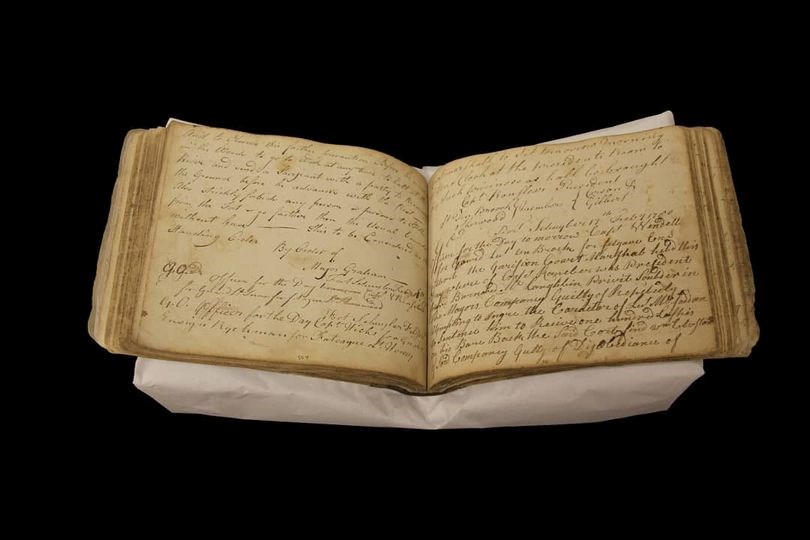
National Park Service
On January 1, 1778, General George Washington issued this summary order to the Continental Army:
"And that the plea of ignorance, which is no excuse for the Neglect of Orders (but rather an Aggravation) may not be offered, It is order’d, and directed, that not only every regiment, but every Company, do keep an Orderly-book, to which frequent recourse is to be had, it being expected that all standing orders be rigidly obeyed, until alter’d or countermanded – It is also expected, that all Orders which are necessary to be communicated to the Men, be regularly read, and carefully explained to them."
The orderly book presented is the Company Orderly Book of Major John Grahm’s Company of the 1st New York Regiment. The orderly book was maintained at Fort Schuyler (now Fort Stanwix) from August 9, 1779 to July 12, 1780.
In the 18th century each regiment of the Continental Army, which could number from 200 to 500 men, was typically broken up into eight or nine companies of 30 to 50 men each. Orderly books served many purposes. First and foremost was military discipline; the orderly book was the company’s official record of all military orders.
"the Adjident is Ordered to furnish the Serjeants and corporals each with their Instructions in Writing in Order that no Ignorance may be pleaded by them for the Futer and the Soldiers made Acquianted with the Different parts of his Daily Duty either in Camp or garrison." [Orderly Book, 14 May 1780]
The orderly book also served to remind soldiers of previously issued orders.
"…the Commandt. officer once more Reminds the Soldiers of the orders of the thirteenth of March last respecting their strolling from the garrison Which sd. orders Will be read this Evening at Roll call… [Orderly Book, 16 April 1780]"
Another essential purpose was to record the routines of daily garrison duty. “Garrison Orders” like these appeared in the Fort Stanwix Orderly Book every day.
"Garrison Orders Fort Schuyler 10th Octr 1779
Officers for the day to Morrow Capt Ransselaer for Guard Lt Tenbroock The usual Number for fatigue to Morrow to parade at 8 Oclock For this duty Capt Parsons Lieuts Henry + Wendell [Orderly Book, 10 October 1779]"
Orderly books also served to document and disseminate Resolutions of Congress...
"In Congress August 18th 1779 ----
Resolved that untill the further order of Congress the sum of ten Dollars be Paid to Every N. Commiss. Offr and Private monthly for their Subsistance in lue of their Articles of Provisions Origanaly Intended for them and not furnished
Extract from the minutes
Charles Thompson
Secretary
[Orderly Book, 24 September 1779]"
...or orders from Headquarters.
"Head Quarters Morris Town Decemr 25th 1779
All Resignations for the future are to be made in the following Manner – The Officer applying will Produce a Certificate from the Auditter that there are no Accts in the Office Unsettled Another from the Regl Pay Master to the Same Effect and Another from the Commanding Officer of the Regimt the latter will also Express that the State of the Regimt does not make the Resignation Improper at the Time – without these no Resignations will be Excepted [Orderly Book, 20 January 1780]"
Each day, either Major Grahm or one of his junior officers met with the regimental adjutant to receive any new rules, orders, or duties for the regiment. Returning to their company quarters, one of these officers then met with the company sergeant and dictated the day’s orders while the sergeant wrote everything down in the company orderly book. The orders for the day were then read aloud before the assembled men of each company.
Depending upon the writing skill and speed of the orderly sergeant, these daily entries might display awkward sentence structure, random capitalization, liberal use of contractions, and phonetically spelled words.
"the Commadt assures the Regt that he has undoubted assureance that the will be releived from this post the following is an Extract from the Genls Orders = govoner Clinton is again Ordered that if Surcomstances will admit of a Detachment of men raise for the fronttier service that the be Immediately sent to releive the garrison of fort Schuyler when they arive Lt Coll V Dyck is to remain & to comd at this post = & the Regt to Joyn the main army [Orderly Book, 30 June 1780]"
Through careful study of period orderly books like this one, we gain greater insight and understanding of how the Continental Army operated, and how the soldiers who made up the army lived and behaved.
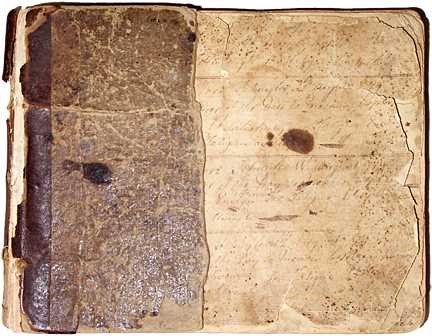
When Fort Stanwix National Monument received the Orderly Book of Major John Grahm’s Company of the 1st New York Regiment, it was in poor condition. Half of the front cover was missing, some of the leather from the spine was detached...
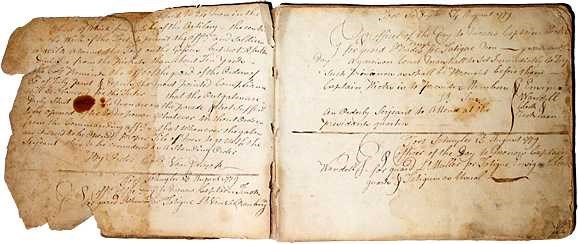
... and many pages were dirty, damaged, tattered or torn.
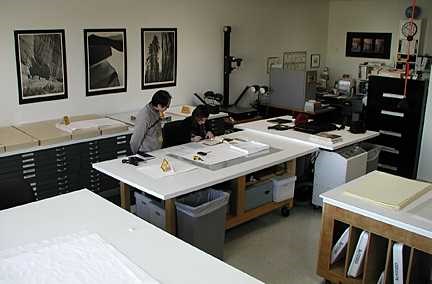
The orderly book was sent to the National Park Service paper conservation laboratory in Harpers Ferry, West Virginia, where paper conservators and specialized contractors were engaged to restore the historic artifact.
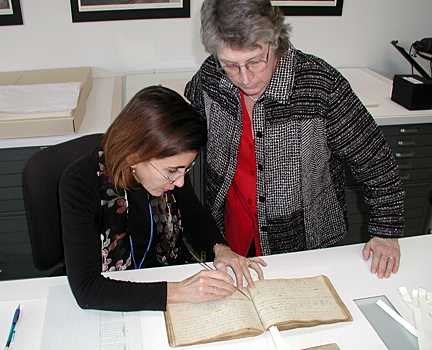
Conservation treatments on damaged and fragile materials require delicate tool skills, manual dexterity, and very sensitive tactile abilities.
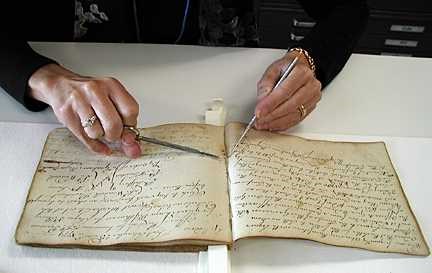
Conservators do not wear gloves when treating the delicate paper, but instead wash their hands carefully before treatment.
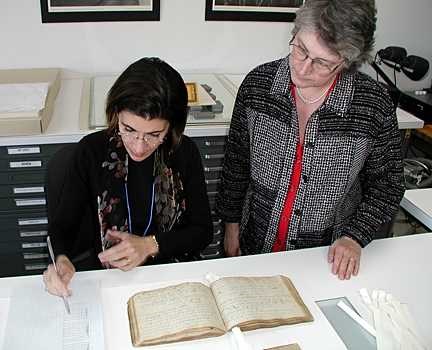
Before conservation treatment begins the Orderly Book is carefully examined and details recorded such as the structure of the book and any damage.
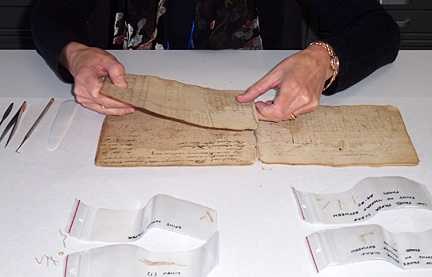
The Orderly Book is disbound, or taken apart, into its separate parts: the front and back covers, sections of pages called “gatherings,” and the spine.
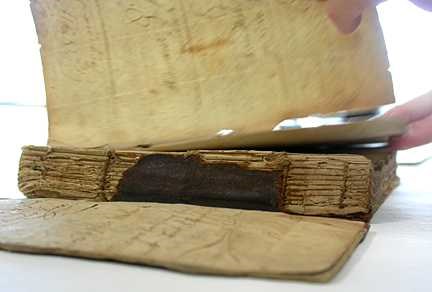
The spine is the hinged flexible leather that holds the front and back covers together.
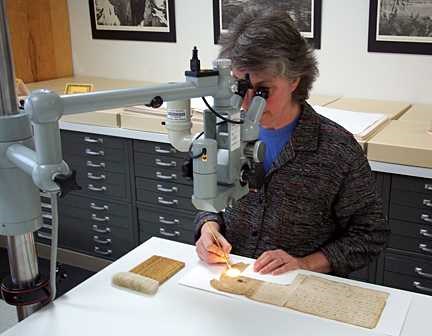
Under a microscope, dirt is removed from the pages individually.
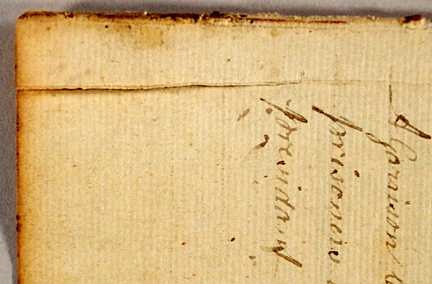
Tears in the paper are mended with laboratory prepared wheat starch paste and thin, but strong, handmade tissue (torn page right).
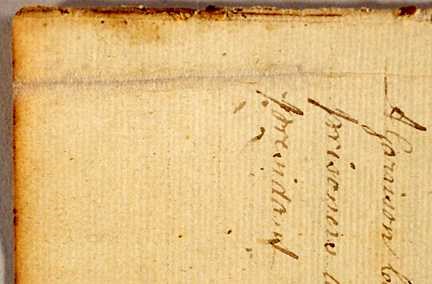
(Mended page on the left).
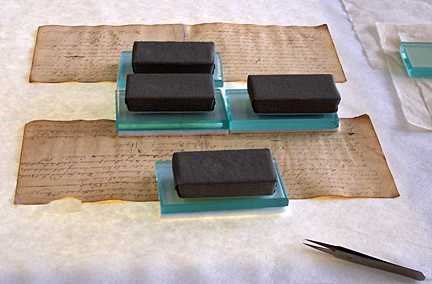
Weight is then applied so the mends will dry flat.
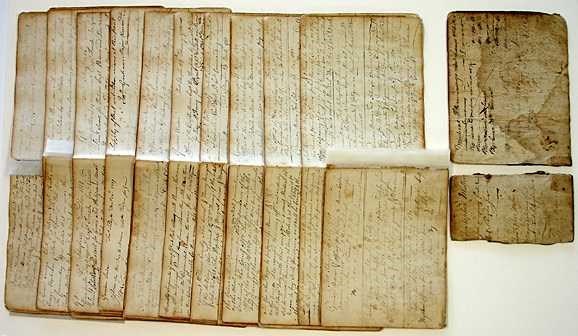
In this picture, all the individual book pages are now cleaned, mended, and organized into their original gatherings and ready to be sewn back together.
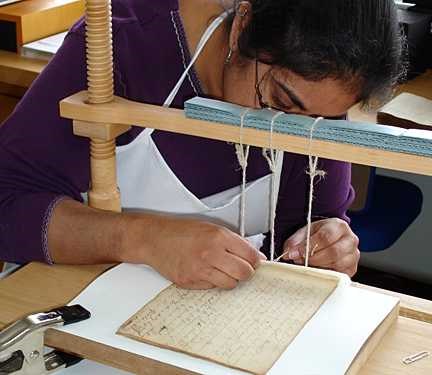
When this book was made in the 18th century, the pages were sewn together. The old, but now mended, sewing holes are used again.
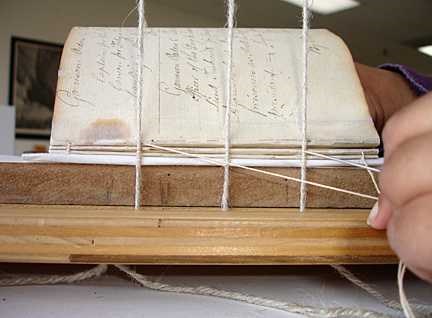
Special linen thread is sewn through folds in the paper and looped around the cords to join the pages back together as a book.
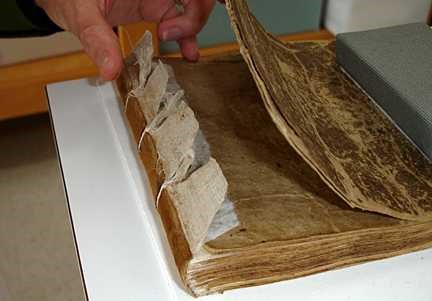
The covers of the Orderly Book were made of layers of thick paper. The original cords were inserted between the cover layers to join together the pages, sewing, and covers. The new cords and tabs of paper and fabric are joined to the covers in the same way.

When the Orderly Book first arrived at the paper conservation laboratory, half of the front cover was missing.
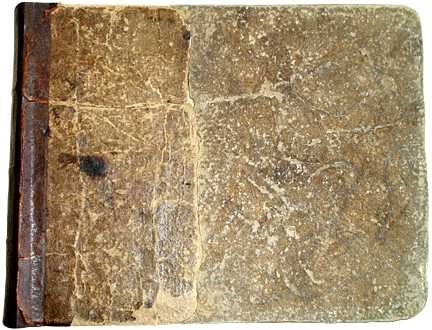
During the conservation treatment, a new section was created for the front cover and attached to the remains of the original cover, thus completing the conservation of the Orderly Book.
Part of a series of articles titled Curious Collections of Fort Stanwix, The Oneida Carry Era.
Previous: Nicholas Herkimer's Field Desk
Next: Animal Bones
Last updated: September 6, 2022